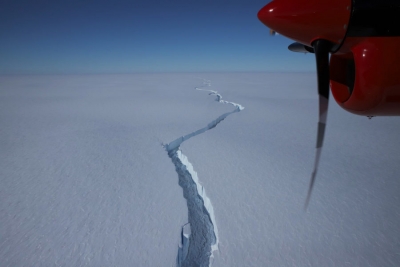London, Feb 27 : Almost a decade after scientists at British Antarctic Survey (BAS) first detected growth of vast cracks, a huge iceberg, more than 20 times the size of Manhattan, in Antarctica’s Brunt Ice Shelf has now broken off.
The first indication that a calving event was imminent came in November 2020 when a new chasm — called North Rift — headed towards another large chasm near the Stancomb-Wills Glacier Tongue 35 kms away, BAS said in a statement on Friday.
North Rift is the third major crack through the ice shelf to become active in the last decade.
During January, this rift pushed northeast at up to 1 km per day, cutting through the 150-metre-thick floating ice shelf.
The iceberg was formed when the crack widened several hundred metres in a few hours on Friday, releasing it from the rest of floating ice shelf.
“Our teams at BAS have been prepared for the calving of an iceberg from Brunt Ice Shelf for years,” said Professor Dame Jane Francis, Director of British Antarctic Survey.
“We monitor the ice shelf daily using an automated network of high-precision GPS instruments that surround the station, these measure how the ice shelf is deforming and moving.We also use satellite images from ESA (European Space Agency), NASA and the German satellite TerraSAR-X.”
The Brunt Ice Shelf is the location of British Antarctic Survey’s (BAS) Halley Research Station.
BAS glaciologists, who have been expecting a big calving event for at least a decade, say that the research station is unlikely to be affected by the current calving.
The glaciological structure of this vast floating ice shelf is complex, and the impact of “calving” events is unpredictable
.






